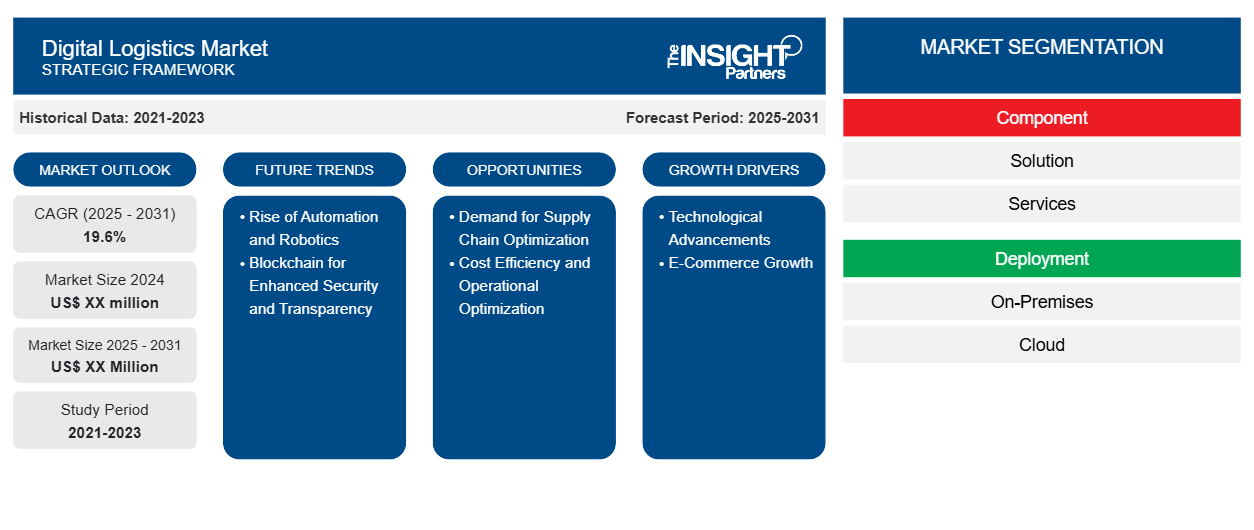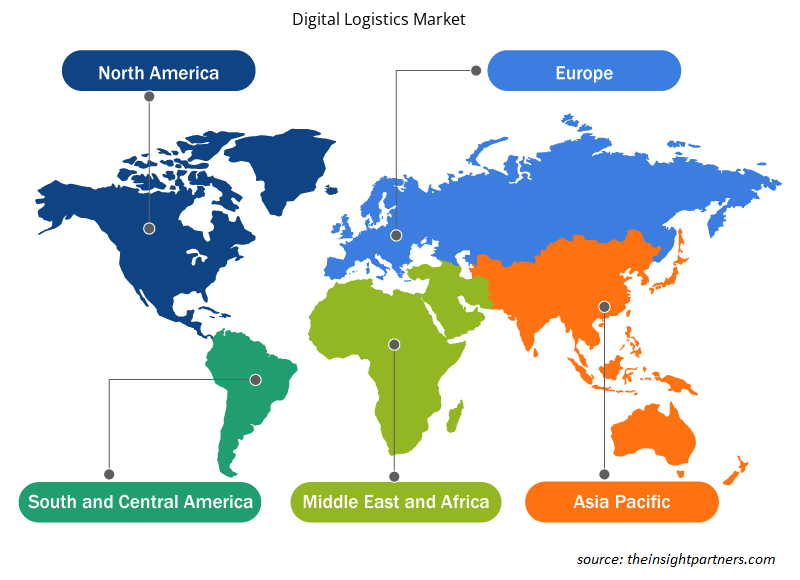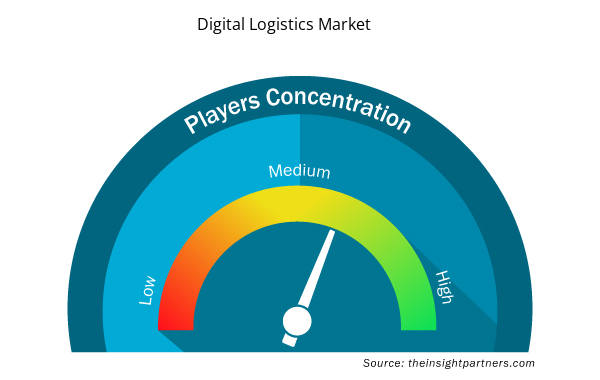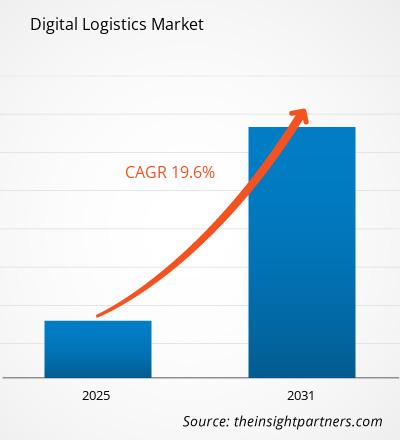من المتوقع أن يسجل سوق الخدمات اللوجستية الرقمية معدل نمو سنوي مركب بنسبة 19.6٪ من عام 2025 إلى عام 2031، مع توسع حجم السوق من XX مليون دولار أمريكي في عام 2024 إلى XX مليون دولار أمريكي بحلول عام 2031.
يُقسّم التقرير حسب المكونات (الحلول (إدارة الأصول، إدارة المستودعات، إدارة الأسطول، إدارة البيانات والتحليلات، وغيرها) والخدمات)، والنشر (محليًا، سحابيًا)، وحجم المؤسسة (الشركات الكبيرة، الشركات الصغيرة والمتوسطة)، والتطبيق (إدارة النقل، إدارة المستودعات، إدارة العمالة، وغيرها)، وقطاع المستخدم النهائي (التصنيع، تجارة التجزئة والسلع الاستهلاكية، الرعاية الصحية، الطاقة والمرافق، السيارات، وغيرها). ويُفصّل التحليل العالمي بشكل أكبر على المستوى الإقليمي والدول الرئيسية. ويُقدّم التقرير القيمة بالدولار الأمريكي للتحليل والقطاعات المذكورة أعلاه.
غرض التقرير
يهدف تقرير "سوق الخدمات اللوجستية الرقمية" الصادر عن شركة "ذا إنسايت بارتنرز" إلى وصف المشهد الحالي والنمو المستقبلي، وأهم العوامل المحفزة، والتحديات، والفرص المتاحة. وسيوفر هذا التقرير رؤى ثاقبة لمختلف أصحاب المصلحة في قطاع الأعمال، مثل:
- مزودي التكنولوجيا/المصنعين: لفهم ديناميكيات السوق المتطورة ومعرفة فرص النمو المحتملة، وتمكينهم من اتخاذ قرارات استراتيجية مستنيرة.
- المستثمرون: إجراء تحليل شامل للاتجاهات فيما يتعلق بمعدل نمو السوق، والتوقعات المالية للسوق، والفرص المتاحة عبر سلسلة القيمة.
- الهيئات التنظيمية: لتنظيم السياسات ومراقبة الأنشطة في السوق بهدف تقليل الانتهاكات والحفاظ على ثقة المستثمرين ودعم سلامة السوق واستقرارها.
تجزئة سوق الخدمات اللوجستية الرقمية
عنصر
- حل
- خدمات
النشر
- في الموقع
- سحاب
حجم المؤسسة
- الشركات الكبيرة
- الشركات الصغيرة والمتوسطة
طلب
- إدارة النقل
- إدارة المستودعات
- إدارة العمل
- آحرون
صناعة المستخدم النهائي
- تصنيع
- تجارة التجزئة والسلع الاستهلاكية
- الرعاية الصحية
- الطاقة والمرافق
- السيارات
- آحرون
قم بتخصيص هذا التقرير ليناسب متطلباتك
ستحصل على تخصيص لأي تقرير - مجانًا - بما في ذلك أجزاء من هذا التقرير، أو تحليل على مستوى الدولة، وحزمة بيانات Excel، بالإضافة إلى الاستفادة من العروض والخصومات الرائعة للشركات الناشئة والجامعات
سوق الخدمات اللوجستية الرقمية: رؤى استراتيجية

- احصل على أهم اتجاهات السوق الرئيسية لهذا التقرير.ستتضمن هذه العينة المجانية تحليل البيانات، بدءًا من اتجاهات السوق وحتى التقديرات والتوقعات.
محركات نمو سوق الخدمات اللوجستية الرقمية
- التطورات التكنولوجية: يُعدّ التقدم التكنولوجي أحد أهمّ العوامل المحفّزة لسوق الخدمات اللوجستية الرقمية. يُسهم دمج إنترنت الأشياء، وتحليلات البيانات الضخمة، والذكاء الاصطناعي، والتعلم الآلي في تبسيط قطاع الخدمات اللوجستية من خلال زيادة وضوح الرؤية، واتخاذ قرارات مدروسة، وتحسين التوجيه. على سبيل المثال، تُتيح الحلول المُدعّمة بإنترنت الأشياء تتبّع الشحنات آنيًا، وتوفير معلومات مُحدّثة عن موقع الشحنة وحالتها آنيًا. من ناحية أخرى، تُساعد خوارزميات الذكاء الاصطناعي والتعلم الآلي شركات الخدمات اللوجستية على توقّع الطلب، وتحسين سلاسل التوريد، وتحسين دقة التنبؤات، مما يُخفّض تكاليف التشغيل ويزيد الكفاءة.
- نمو التجارة الإلكترونية: يُعدّ النمو الهائل في مجال التجارة الإلكترونية أحد المحركات الرئيسية لسوق الخدمات اللوجستية الرقمية. ومع استمرار نموّ الشراء عبر الإنترنت، ازدادت الحاجة إلى حلول لوجستية أسرع وأكثر كفاءة بشكل متناسب. يتوقع المستهلك اليوم توصيلًا أسرع، وتتبعًا آنيًا، وشفافية أكبر من أي وقت مضى. ولتلبية هذه التوقعات، يزداد اعتماد قطاع التجارة الإلكترونية على الحلول اللوجستية الرقمية لتسريع إنجاز الطلبات، وتحسين خدمة التوصيل في الميل الأخير، وتقليل فترات التسليم. وهذا بدوره يتيح لشركات الخدمات اللوجستية فرصة الاستفادة من المنصات الرقمية التي تُمكّنها من إدارة أحجام الطلبات المتزايدة وتنفيذ عمليات لوجستية مُعقدة بكفاءة أعلى.
اتجاهات مستقبل سوق الخدمات اللوجستية الرقمية
- صعود الأتمتة والروبوتات: يتزايد اعتماد قطاع الخدمات اللوجستية على الأتمتة والروبوتات، سعيًا لتوفير تكاليف العمالة مع زيادة الكفاءة والحد من نقصها. وتزداد شيوع المستودعات الآلية، حيث تتولى الروبوتات مهام الفرز والتغليف وإدارة المخزون. كما تُختبر وتُنشر حاليًا مركبات التوصيل ذاتية القيادة، بما في ذلك الطائرات بدون طيار والشاحنات ذاتية القيادة، في مختلف الأسواق. ولا تقتصر هذه التقنيات على تعزيز الكفاءة التشغيلية فحسب، بل تُقلل أيضًا من احتمالية حدوث أخطاء بشرية، وتُعزز السلامة، وتُزيد من الإنتاجية. ومع تزايد انتشار الأتمتة، تتاح فرصة كبيرة لشركات الخدمات اللوجستية الرقمية لإدخال هذه التقنيات في خدماتها.
- بلوكتشين لتعزيز الأمن والشفافية: تُصبح تقنية بلوكتشين توجهًا رئيسيًا في مجال اللوجستيات الرقمية، لا سيما لتحسين شفافية وأمن سلسلة التوريد. تُوفر بلوكتشين سجلًا لامركزيًا ثابتًا يضمن أصالة البضائع، ويتتبّع المنتجات من المنشأ حتى التسليم، ويمنع الاحتيال في سلسلة التوريد. ومن خلال تطبيق بلوكتشين، يُمكن لمُقدّمي الخدمات اللوجستية توفير تتبع آمن وفوريّ للشحنات والتحقق منها للعملاء. تُساعد هذه التقنية الشركات على تعزيز الثقة والشفافية في العمليات اللوجستية، مما يجعلها حلاًّ مُلفتًا لقطاعات مثل الأدوية والسلع الفاخرة والأغذية حيث يُعدّ الأمن والأصالة أمرًا بالغ الأهمية.
فرص سوق الخدمات اللوجستية الرقمية
- الطلب على تحسين سلاسل التوريد: تزداد سلاسل التوريد العالمية تعقيدًا، مع تعدد نقاط الاتصال والشحنات الدولية وأنماط الطلب المتغيرة، مما يُبرز حاجة المؤسسات إلى اعتماد حلول لوجستية رقمية تُتيح رؤية شاملة وإدارة آنية لسلاسل التوريد. في العمليات التجارية المعاصرة، تُمكّن أدوات مثل منصات البرمجيات السحابية، وتحليلات البيانات، والتوائم الرقمية - المعروفة بنماذج افتراضية لسلاسل التوريد - المؤسسات من تتبع المخزون بدقة، وتحسين المسارات، وإدارة المستودعات، والحد من أوجه القصور في العمليات اللوجستية. يُتيح الطلب المتزايد على سلاسل توريد أكثر ذكاءً وترابطًا فرصًا كبيرة لمقدمي الخدمات اللوجستية الرقمية لتقديم حلول شاملة قائمة على البيانات.
- كفاءة التكلفة وتحسين العمليات: بفضل كفاءة التكلفة، إلى جانب تحسين العمليات، ستُمكّن هذه الحلول اللوجستية الرقمية الشركات من الارتقاء بكفاءتها وأدائها مع خفض التكاليف. تُقلل أتمتة مهام مثل إدارة المخزون ومعالجة الطلبات وجدولة عمليات التسليم من نفقات العمالة الكبيرة وانخفاض الكفاءة التشغيلية. علاوة على ذلك، ستتمكن التحليلات في هذا المجال من تتبع اختناقات سلسلة التوريد، مما يُمكّن الشركات من اتخاذ خيارات مدروسة تُقلل من تأخير العمليات وتُهدر الموارد. مع تزايد الضغوط على شركات الخدمات اللوجستية لخفض النفقات وزيادة هوامش الربح، سيزداد الطلب على الحلول الرقمية التي تُساعد على تحسين كفاءة العمليات اللوجستية بشكل كبير.
رؤى إقليمية حول سوق الخدمات اللوجستية الرقمية
قام محللو إنسايت بارتنرز بشرح شامل للاتجاهات والعوامل الإقليمية المؤثرة في سوق الخدمات اللوجستية الرقمية خلال فترة التوقعات. ويناقش هذا القسم أيضًا قطاعات سوق الخدمات اللوجستية الرقمية ومناطقها الجغرافية في أمريكا الشمالية، وأوروبا، وآسيا والمحيط الهادئ، والشرق الأوسط وأفريقيا، وأمريكا الجنوبية والوسطى.

- احصل على البيانات الإقليمية المحددة لسوق الخدمات اللوجستية الرقمية
نطاق تقرير سوق الخدمات اللوجستية الرقمية
| سمة التقرير | تفاصيل |
|---|---|
| حجم السوق في عام 2024 | XX مليون دولار أمريكي |
| حجم السوق بحلول عام 2031 | XX مليون دولار أمريكي |
| معدل النمو السنوي المركب العالمي (2025 - 2031) | 19.6% |
| البيانات التاريخية | 2021-2023 |
| فترة التنبؤ | 2025-2031 |
| القطاعات المغطاة | حسب المكون
|
| المناطق والدول المغطاة | أمريكا الشمالية
|
| قادة السوق وملفات تعريف الشركات الرئيسية |
|
كثافة اللاعبين في سوق الخدمات اللوجستية الرقمية: فهم تأثيرها على ديناميكيات الأعمال
يشهد سوق الخدمات اللوجستية الرقمية نموًا سريعًا، مدفوعًا بتزايد طلب المستخدم النهائي نتيجةً لعوامل مثل تطور تفضيلات المستهلكين، والتقدم التكنولوجي، وزيادة الوعي بمزايا المنتج. ومع تزايد الطلب، تعمل الشركات على توسيع عروضها، والابتكار لتلبية احتياجات المستهلكين، والاستفادة من الاتجاهات الناشئة، مما يعزز نمو السوق.
تشير كثافة اللاعبين في السوق إلى توزيع الشركات العاملة في سوق أو قطاع معين. وتشير إلى عدد المنافسين (اللاعبين في السوق) الموجودين في سوق معين نسبةً إلى حجمه أو قيمته السوقية الإجمالية.
الشركات الرئيسية العاملة في سوق الخدمات اللوجستية الرقمية هي:
- ويب إكسبريس
- شركة آي بي إم
- شركة تيك ماهيندرا المحدودة
- شركة إنفوسيس المحدودة
- شركة إتش سي إل تكنولوجيز المحدودة
- الملكية الفكرية لشركة AT&T
إخلاء المسؤولية : الشركات المذكورة أعلاه ليست مرتبة بأي ترتيب معين.

- احصل على نظرة عامة على أهم اللاعبين الرئيسيين في سوق الخدمات اللوجستية الرقمية
نقاط البيع الرئيسية
- التغطية الشاملة: يغطي التقرير بشكل شامل تحليل المنتجات والخدمات والأنواع والمستخدمين النهائيين لسوق الخدمات اللوجستية الرقمية، مما يوفر مشهدًا شاملاً.
- تحليل الخبراء: تم تجميع التقرير على أساس الفهم العميق لخبراء الصناعة والمحللين.
- المعلومات الحديثة: يضمن التقرير أهمية الأعمال التجارية بسبب تغطيته للمعلومات الحديثة واتجاهات البيانات.
- خيارات التخصيص: يمكن تخصيص هذا التقرير لتلبية متطلبات العملاء المحددة وتلبية استراتيجيات العمل بشكل مناسب.
لذا، يُمكن لتقرير البحث حول سوق الخدمات اللوجستية الرقمية أن يُساعد في تمهيد الطريق لفهم سيناريوهات القطاع وآفاق نموه. ورغم وجود بعض المخاوف المُبررة، إلا أن فوائد هذا التقرير الإجمالية تفوق عيوبه.
- التحليل التاريخي (سنتان)، السنة الأساسية، التوقعات (7 سنوات) مع معدل النمو السنوي المركب
- تحليل PEST و SWOT
- حجم السوق والقيمة / الحجم - عالميًا وإقليميًا وقطريًا
- الصناعة والمنافسة
- مجموعة بيانات Excel



Report Coverage
Revenue forecast, Company Analysis, Industry landscape, Growth factors, and Trends

Segment Covered
This text is related
to segments covered.

Regional Scope
North America, Europe, Asia Pacific, Middle East & Africa, South & Central America

Country Scope
This text is related
to country scope.
الأسئلة الشائعة
Rise of Automation and Robotics is anticipated to play a significant role in the global digital logistics market in the coming years
The report can be delivered in PDF/PPT format; we can also share excel dataset based on the request
Some of the customization options available based on the request are an additional 3-5 company profiles and country-specific analysis of 3-5 countries of your choice. Customizations are to be requested/discussed before making final order confirmation as our team would review the same and check the feasibility
The major factors driving the digital logistics market are:
1. Technological Advancements
2. E-Commerce Growth
The Digital Logistics Market is estimated to witness a CAGR of 19.6% from 2023 to 2031
The List of Companies
1. Accenture
2. Advantech Co., Ltd.
3. DigiLogistics Technology Ltd.
4. Hexaware Technologies Limited
5. IBM Corporation
6. Oracle
7. Samsung
8. SAP SE
9. Siemens Digital Logistics GmbH
10. Tech Mahindra Limited
The Insight Partners performs research in 4 major stages: Data Collection & Secondary Research, Primary Research, Data Analysis and Data Triangulation & Final Review.
- Data Collection and Secondary Research:
As a market research and consulting firm operating from a decade, we have published and advised several client across the globe. First step for any study will start with an assessment of currently available data and insights from existing reports. Further, historical and current market information is collected from Investor Presentations, Annual Reports, SEC Filings, etc., and other information related to company’s performance and market positioning are gathered from Paid Databases (Factiva, Hoovers, and Reuters) and various other publications available in public domain.
Several associations trade associates, technical forums, institutes, societies and organization are accessed to gain technical as well as market related insights through their publications such as research papers, blogs and press releases related to the studies are referred to get cues about the market. Further, white papers, journals, magazines, and other news articles published in last 3 years are scrutinized and analyzed to understand the current market trends.
- Primary Research:
The primarily interview analysis comprise of data obtained from industry participants interview and answers to survey questions gathered by in-house primary team.
For primary research, interviews are conducted with industry experts/CEOs/Marketing Managers/VPs/Subject Matter Experts from both demand and supply side to get a 360-degree view of the market. The primary team conducts several interviews based on the complexity of the markets to understand the various market trends and dynamics which makes research more credible and precise.
A typical research interview fulfils the following functions:
- Provides first-hand information on the market size, market trends, growth trends, competitive landscape, and outlook
- Validates and strengthens in-house secondary research findings
- Develops the analysis team’s expertise and market understanding
Primary research involves email interactions and telephone interviews for each market, category, segment, and sub-segment across geographies. The participants who typically take part in such a process include, but are not limited to:
- Industry participants: VPs, business development managers, market intelligence managers and national sales managers
- Outside experts: Valuation experts, research analysts and key opinion leaders specializing in the electronics and semiconductor industry.
Below is the breakup of our primary respondents by company, designation, and region:

Once we receive the confirmation from primary research sources or primary respondents, we finalize the base year market estimation and forecast the data as per the macroeconomic and microeconomic factors assessed during data collection.
- Data Analysis:
Once data is validated through both secondary as well as primary respondents, we finalize the market estimations by hypothesis formulation and factor analysis at regional and country level.
- Macro-Economic Factor Analysis:
We analyse macroeconomic indicators such the gross domestic product (GDP), increase in the demand for goods and services across industries, technological advancement, regional economic growth, governmental policies, the influence of COVID-19, PEST analysis, and other aspects. This analysis aids in setting benchmarks for various nations/regions and approximating market splits. Additionally, the general trend of the aforementioned components aid in determining the market's development possibilities.
- Country Level Data:
Various factors that are especially aligned to the country are taken into account to determine the market size for a certain area and country, including the presence of vendors, such as headquarters and offices, the country's GDP, demand patterns, and industry growth. To comprehend the market dynamics for the nation, a number of growth variables, inhibitors, application areas, and current market trends are researched. The aforementioned elements aid in determining the country's overall market's growth potential.
- Company Profile:
The “Table of Contents” is formulated by listing and analyzing more than 25 - 30 companies operating in the market ecosystem across geographies. However, we profile only 10 companies as a standard practice in our syndicate reports. These 10 companies comprise leading, emerging, and regional players. Nonetheless, our analysis is not restricted to the 10 listed companies, we also analyze other companies present in the market to develop a holistic view and understand the prevailing trends. The “Company Profiles” section in the report covers key facts, business description, products & services, financial information, SWOT analysis, and key developments. The financial information presented is extracted from the annual reports and official documents of the publicly listed companies. Upon collecting the information for the sections of respective companies, we verify them via various primary sources and then compile the data in respective company profiles. The company level information helps us in deriving the base number as well as in forecasting the market size.
- Developing Base Number:
Aggregation of sales statistics (2020-2022) and macro-economic factor, and other secondary and primary research insights are utilized to arrive at base number and related market shares for 2022. The data gaps are identified in this step and relevant market data is analyzed, collected from paid primary interviews or databases. On finalizing the base year market size, forecasts are developed on the basis of macro-economic, industry and market growth factors and company level analysis.
- Data Triangulation and Final Review:
The market findings and base year market size calculations are validated from supply as well as demand side. Demand side validations are based on macro-economic factor analysis and benchmarks for respective regions and countries. In case of supply side validations, revenues of major companies are estimated (in case not available) based on industry benchmark, approximate number of employees, product portfolio, and primary interviews revenues are gathered. Further revenue from target product/service segment is assessed to avoid overshooting of market statistics. In case of heavy deviations between supply and demand side values, all thes steps are repeated to achieve synchronization.
We follow an iterative model, wherein we share our research findings with Subject Matter Experts (SME’s) and Key Opinion Leaders (KOLs) until consensus view of the market is not formulated – this model negates any drastic deviation in the opinions of experts. Only validated and universally acceptable research findings are quoted in our reports.
We have important check points that we use to validate our research findings – which we call – data triangulation, where we validate the information, we generate from secondary sources with primary interviews and then we re-validate with our internal data bases and Subject matter experts. This comprehensive model enables us to deliver high quality, reliable data in shortest possible time.

 احصل على عينة مجانية لهذا التقرير
احصل على عينة مجانية لهذا التقرير